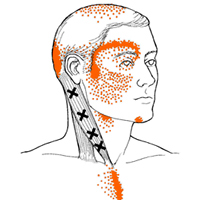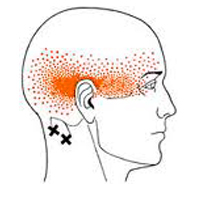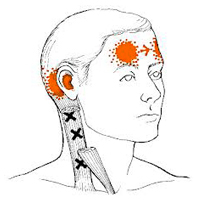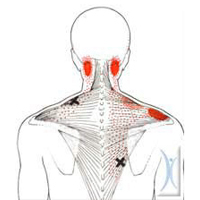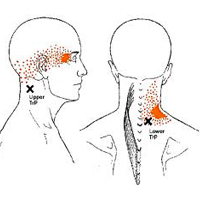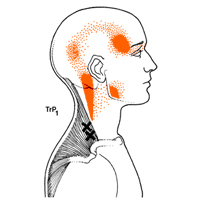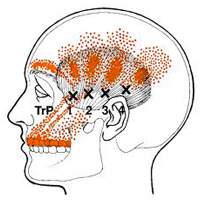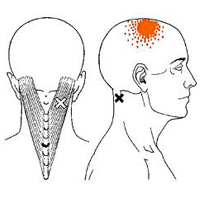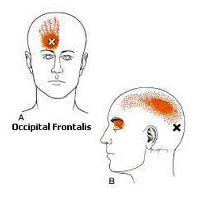Do you have a chronic headache pattern? Does it resemble any of the images below? If so, click on the image to learn more about your particular headache, and how it can be treated. If you don’t find your headache, don’t worry. This is only a sample of the most common culprits.
Trapezius
Symptoms
Trapezius is responsible for more pain than any other muscle in the body. It is a frequently overlooked source of head and neck pain. The characteristic trapezius headache manifests in the temples and often is accompanied by pain in the shoulders and in the back and sides of the neck.
Causes of Pain
Shoulders that are habitually hunched and rounded forward, whether from anxiety or work posture, chronically shorten the fibers of the upper traps.
Treatment
The first order of business is to lengthen the hunched muscles, so the shoulders can descend away from the ears. I use a combination of softening and lengthening techniques from structural integration, neuromuscular therapy, and Swedish massage.
Next, we open the muscles of the upper chest, so the shoulders can relax backward. This keeps the trapezius out of its rounded-forward position and gives it a more manageable workload. Gentle traction of the neck is applied to elongate the chronically-shortened upper portion. Within the client’s comfort range, muscles in the front of the neck are also released, giving further length to the neck.
The SternoCleidoMastoid
The SternoCleidoMastoid is one of the most under-treated muscles in the body. It is short on most people and accounts for the head-forward posture that is so common today. Because it is responsible for protecting the head from excess movement, it one of the primary muscles strained in whiplash.
Presentation
If you spend most of your day slumped over a desk and squinting at a screen, this treatment is for you. If your head protrudes in front of the rest of you or is rotated uncomfortably to one side, this muscle needs to be lengthened.
Symptoms
Its two branches produce distinct pain patterns. The sternal division causes eye and face pain, as well as numbness and tingling in the face. Autonomic eye and sinus symptoms may also be attributed to muscular tension in the sternal division, particularly in the presence of other symptoms of muscle tension.
Tension in the clavicular division results in frontal headache and earache, as well as ringing in the ears known as tinnitus.
Treatment
The muscles of the SCM frame the throat, and are located on top of the carotid artery, so they must be approached with care. They are lengthened using myofascial release, which is gentle, relaxing, and noninvasive. The client is coached on posture and is given simple stretches to maintain muscle length. Further massage in the suboccipitals at the base of the skull allows the head and neck to ease backward, relieving SCM of its heavy load. All posterior cervical muscles will need some work to allow the neck to lengthen and ascend.
It may be necessary to make sure the client’s eye prescription is current, so the need for leaning into a computer or reading material is eliminated.
The Suboccipitals
Symptoms
The suboccipitals frequently receive inadequate circulation and are thus another common source of headaches. They generate “Deep head pain that radiates from occiput towards the region of the [eye].” (Travell)
Presentation
A client with shortened suboccipitals presents with a head-forward posture, a compressed upper neck, and/or a slumped, collapsed posture with the head of the arm bones rolled forward. Since these are small muscles, pain rarely presents by itself. It is usually in conjunction with trigger points in larger overlying muscles, such as splenius capitus and trapezius, which must also be treated.
Treatment
While these muscles are quite sore when activated, treatment is often deliciously relaxing. This is because they reach directly into the dural tissue surrounding the spinal cord. Relaxing the suboccipitals thus relaxes the entire nervous system, creating a sensation of deep calm. The therapist places her fingertips at the base of the client’s skull and allows the head to gently sink into the fingertips. The head’s own weight applies gentle pressure to the suboccipitals, which gradually softens.
Splenius Capitis
Splenius capitis is a posterior neck muscle attached at the base of the skull. With SCM, it is a central component to whiplash.
Symptoms
Pain is projected to the vertex of the skull. Blurred vision to the same side-eye may also present. Active trigger points will cause restricted neck rotation and flexion.
Treatment
Treatment of this muscle involves deep-tissue and/or Swedish massage to the back of the neck, and is primarily concerned with bringing adequate blood flow into the area. The underlying suboccipital muscles must also be addressed.
Splenius Cervicis
Splenius cervicis projects pain to the occiput (base of the skull) and just behind the eye: an “ache inside the skull”. It may also cause blurred vision to the eye of the affected side. There is frequently an accompanying pain where the neck meets the shoulder. Active trigger points will cause restricted neck rotation and flexion. Treatment of this muscle involves deep-tissue and/or Swedish massage to the back of the neck, and is primarily concerned with bringing adequate blood flow into the area, rather than lengthening.
Temporalis
Symptoms
Temporalis is a fan-shaped muscle responsible for closing the jaw. As its name suggests, the temporalis muscle refers pain into the temples. It also refers to pain above the eyebrow and causes toothache in the upper teeth. In tension-type headache and cervicogenic headache, temporalis is typically a common component.
Presentation
Temporalis pain most commonly results from clenching or grinding (bruxism), and from prolonged immobilization of the jaw, such as during dental work. Temporalis tension rarely presents alone, but rather in concert with other jaw muscles.
Treatment
Because temporalis is a flat muscle that fans out across the skull, it responds best to careful myofascial work that provides lengthening tension, rather than deep, downward pressure. Gentle kneading to bring circulation to the area can also be extremely effective. Full treatment for this muscle includes correction of the head-forward posture, as well as manual therapy to the muscles of the jaw and anterior neck.
Semispinalis Capitis and Cervicis
Presentation
For every inch the head sits forward on your body, it gains approximately 10 lbs in weight. Like all muscles in this section, Semispinalis capitis is responsible for attaching the neck and head to the back. We tend to make its job harder by letting our head project forward. The goal of treatment is to lighten the heavy load by returning the head to its natural position. With the head positioned directly over the spine, minimal muscle effort is required to keep it there. We use gravity as our main source of balance and support.
Symptoms
These muscles project pain to the back of the head, and in a strip centered just above and behind the eye.
Treatment
Treatment of this muscle involves deep-tissue and/or Swedish massage to the back of the neck, and is primarily concerned with bringing adequate blood flow into the area, plus lengthening the antagonist muscles in the front of the neck.
Occipito-Frontalis
Clients are often surprised to learn that they have muscles on their scalp. Unfortunately, these muscles can also produce substantial headaches. Pain can project over the forehead, into the back of the head, and behind the eye.
Stress can result from direct trauma by being hit on the head, or through the habit of wrinkling the forehead. It can also be a byproduct of trigger point activity in the SCM muscle.
The good news is that, for most of us, there is hardly anything more relaxing than a scalp massage! In the case of an impact injury, treatment involves myofascial release to gently soften the resulting adhesions. For forehead wrinklers, simple behavioral modification is necessary. But for many, relaxing scalp massage may be all that’s needed to relieve the pain.

